Going against the grain of their usual approach, Ken Burns and producing partner Lynn Novick have seen to it that historians, sociologists, and other assorted academics are kept out of The Vietnam War.
The history is still too recent and raw for that. Others don’t have to tell you what people may or may not have been thinking. In this monumental 18-hour, 10-part undertaking, it’s the participants speaking for themselves in ways that cut deep and keep reverberating. Hello darkness, my old friend. I’ve come to talk with you again. In terms of the destructive, divisive, decibel-shattering “Living Room War,” sounds of silence have never been much of an option. It all begins on Sept. 17th and will run for two weeks, Sundays to Thursdays, through Sept. 28th on PBS (check local listings).
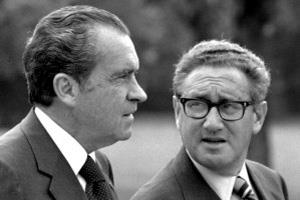
Burns and Novick also have chosen (wisely in this view) not to interview the surviving big names of the Vietnam War era. The likes of John Kerry, Jane Fonda, Henry Kissinger (right), and John McCain are seen and heard from in archival footage. But the face-to-the-camera storytelling is left to largely unknown soldiers on both sides, plus others who were directly involved in or affected by a war that ended the lives of more than 58,000 Americans, at least 250,000 South Vietnamese, and more than a million Viet Cong and North Vietnamese. There are 79 such interviews in all, by Burns’ count.
If a star is born, it might well be blunt-spoken Marine Corps veteran John Musgrave, whose way with words keeps cutting to the bone. Musgrave suffered nearly life-ending wounds in combat, returned in a suicidal state and eventually found salvation as a bearded, woolly-haired dissenter. Throughout this long march of a film, he consistently jumps off the screen by running the gamut. His story is by no means the only one. But it merits being spotlighted as a narrative-driving linchpin of the most contemporary history ever attempted by Burns.
In Part 2, subtitled “Riding the Tiger,” Musgrave says for starters, “We were probably the last kids of any generation that actually believed our government would never lie to us.”
Part 5 (“This Is What We Do”) finds him remembering the stark realities of patrolling Vietnam in search of the enemy and those all-important “body counts” touted by generals and relayed for public consumption. His 1st Batallion, 9th Marines unit was dubbed “The Walking Dead” for all the casualties it took.
“They wouldn’t hit us unless they out-numbered us,” Musgrave says. “And we were fightin’ in their yard. They knew the ground, and we didn’t. They were just really good.”
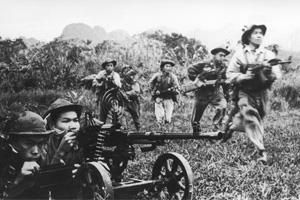
He grew to both fiercely hate and fear the enemy, Musgrave says. The only “human being” he killed was his first. After that, he objectified the Viet Cong and North Vietnamese as sub-human “gooks” and “dinks.” It was straight from the racist toolbox, Musgrave acknowledges. And it served him well in combat until the day he was all but pronounced dead from a deep chest wound among others.
Musgrave recalls that the seemingly out-of-body screams he heard, in fact, were coming from him. After that, “I kept telling ‘em to leave me. And I meant it.”
But Marines never leave their wounded behind, he says with teeth-clenched admiration. And so he survived at least three “nothing they could do for him” triages and eventually 17 months in various Navy hospitals.
Part 8 (“The History of the World”), which is incredibly moving throughout, finds Musgrave again wondering what hit him as the anti-war protests escalated.
“It did more than piss us off,” he says. “It broke our hearts.”
He tried to re-enlist, but his wounds prohibited it. For a while Musgrave instead agreed to become a recruiter but began souring on that after reading about how the Vietnam War had been grounded in deception at the highest levels. Drinking heavily, he put a loaded pistol to his head on more than one occasion. On one particular night, only his dogs clamoring to get back in the house stopped him, Musgrave believes. It’s the only time he stammers and nearly loses it.
Part 8 ends with the Ohio State National Guard’s fatal shootings of four Kent State University students. It was the turning point that made Musgrave a full-blown war protestor.
“I wasn’t helping anybody by keeping my mouth shut,” he says in Part 9 (“A Disrespectful Loyalty”). So Musgrave joined Kerry in publicly throwing away his war medals. Initially appalled by this, his dad stood up for him when those who hadn’t served accused him of disgracing “our medals.” You earned them, they didn’t, the son was told. Musgrave never loved his father more than on that day.
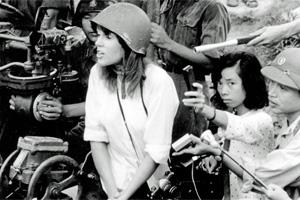
Fonda’s joyful appearances with the North Vietnamese enemy ([right] it forever branded her “Hanoi Jane” in the minds of many), were hard to take for Musgrave, too. Among her pronouncements were that U.S. prisoners of war in fact should be tried as war criminals and then executed.
“Yes, we have a right to be pissed off at her,” Musgrave says. “But you know, she wasn’t the only one. She’s just the only one that we fantasized about” as the sex symbol from Barbarella.
In the climactic Chapter 10 (“The Weight of Memory”), Musgrave found it appalling that some would cheer the fall of Saigon to the enemy he had fought against and almost died to defeat.
“I said, ‘No, it’s not a great day.’ That wasn’t anything to celebrate.”
The 1982 opening of Washington, D.C.’s Vietnam Veterans Memorial, with its etched names of the more than 58,000 U.S. dead, gave Musgrave and many of his surviving comrades at least some reason to feel whole again.
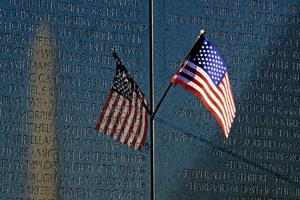
“I collapsed” while approaching it for the first time, he recalls. “And all the tears I’d been holding back -- I didn’t cry. I sobbed. I was on my knees sobbing.”
Watching the entirety of The Vietnam War, in just three days time for review purposes, left a wash of feelings and emotions for one who very much lived through those times (more on this in a brief postscript). What’s more, there’s no fiddle music! Burns and Novick have infused their most daring documentary with more than 120 original tracks from The Beatles, The Rolling Stones, Bob Dylan, Sam Cooke, Jimi Hendrix, Simon & Garfunkel, Janis Joplin, The Byrds, Buffalo Springfield, Crosby, Stills, Nash & Young, and many more. There’s also original music from Trent Reznor, Atticus Ross, Yo-Yo Ma, and The Silk Road Ensemble.
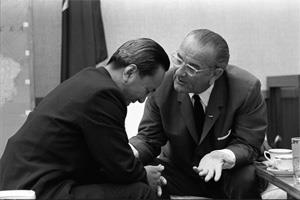
Lesser-known audio clandestinely recorded by Presidents Lyndon B. Johnson (left) and Richard Nixon likewise jolts and informs this film. In 1965, after authorizing the first ground troops in Vietnam, LBJ tells Sen. Richard Russell Jr. of Georgia, “There ain’t no daylight in Vietnam. There’s not a bit.” Yet the escalation continued.
As tapes of a one-on-one confrontation also show, Nixon denied going behind Johnson’s back during the closing days of the 1968 presidential campaign. In truth, Nixon had sought to torpedo impending peace talks by persuading the South Vietnamese government to wait for a better deal from him than they’d get from LBJ and/or Democratic Party nominee Hubert Humphrey.
“Nixon was lying, and Johnson knew it,” narrator Peter Coyote says. But although he considered this treason, LBJ never went public because Nixon’s subterfuge had been documented by a CIA wiretap that would put his administration in a bad light. The horrors at the top just never seem to stop.
There’s so much more during these 18 hours, and The Vietnam War keeps bringing it home via the ferocity of the battles in both Vietnam and increasingly at home. Combat footage is particularly intense in Part 6 during the full-out Tet Offensive mounted by the enemy. “All that was left of Hue was ruins divided by a river,” says a U.S. soldier. And the pictures provide devastating proof.
A few constructive criticisms: Burns and Novick at times have a tendency to force-feed a story thread. And in this view, they do that with the considerable time devoted to a gung-ho and eventually ill-fated soldier named Denton “Mogie” Crockett Jr. Less “Mogie” would have gone a long way.
Coyote brings his trademark gravitas throughout, but the filmmakers might want to consider a narrative change of pace down the road. This is a subject that calls for a somber tone, but Coyote at this point borders on being one-note.
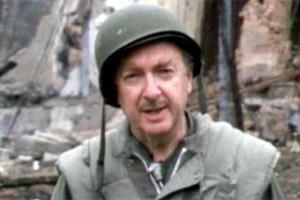
It’s also puzzling that CBS news anchor Walter Cronkite’s famed condemnation of the war is deservedly played at length while LBJ’s reported reaction to aides -- “If I’ve lost Cronkite, I’ve lost Middle America” -- goes completely unmentioned.
These amount to quibbles, though. The Vietnam War excels on so many levels, including its perspectives from the Vietnamese survivors.
The U.S. had a two-brother rule that sanctioned only one brother in a combat zone at a time. Not so with the Viet Cong. Nguyen Thanh Tung, an only daughter, says she lost all eight of her brothers at various stages of the many wars for control of Vietnam. And then her two sons also were killed in combat.
Tran Ngoc Toan, an indomitable South Vietnamese officer fighting for the American side, remembers playing dead while the enemy poked at his body after a devastating firefight. He then survived for three days with his serious wounds before hearing that he “smells like a dead rat” upon being rescued.
Years after the fall of Saigon to the Communists, Le Cong Huan of the Viet Cong says, “Even though I still have bullets in my body, I want to close the war chapter.”
In its scope and a mostly impeccable selection of images, quotes and anecdotes (Ho Chi Minh once worked as a New York city pastry chef), The Vietnam War boldly and bravely stands its ground and almost assuredly will stand the test of time. Its story is told in affectingly human terms by the mostly unheralded men and women who bled, died, and survived.
“In Vietnam, we have finally reached the end of the tunnel. And there is no light there,” Cronkite told his viewers after Saigon officially fell on April 30, 1975.
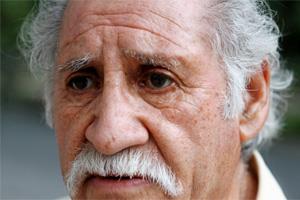
The Vietnam War joins two other Burns epics, The Civil War and The War -- this time in illuminating what happened between 1965 (when American boots officially first hit the ground) and 1975 (when Master Sgt. Juan Valdez, right, became the last American air-lifted out).
It’s all almost two generations removed at this point. But for my older generation, it often seems like no time at all.
A PERSONAL POSTSCRIPT -- Fifty years ago this fall, I made my first trip to sunny Southern California. Destination: Marine Corps boot camp in San Diego.
I joined in hopes of becoming a “man.” And also to get enough money via the G.I. Bill to attend college.
My brother enlisted after I did, but beat me to Vietnam. For some reason, I was first sent to electronics school, a vocation for which I still have no aptitude. When it became time for my Vietnam tour, brother Jim was still over there. The two-brother rule, as noted in both the above review and in The Vietnam War, spared me a trip to Southeast Asia.
My brother returned safely and was discharged early while I remained in the Corps for my full three-year enlistment until being honorably discharged as a Corporal in October 1970. I was never deployed to Vietnam, instead ordered to set sail with the Marine Corps component of the Navy’s Mediterranean-deployed Sixth Fleet before spending my final year as a brig guard at Camp Pendleton.
As a student at the University of Wisconsin-Madison, I then ended up joining in protests against the Vietnam War during its final stages.
You might say I came full circle. And while watching The Vietnam War I sometimes felt a little dizzy all over again.